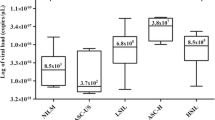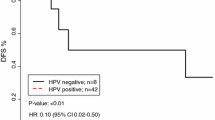Abstract
PURPOSE: The purpose of this study was to determine the incidence of human papillomavirus deoxyribonucleic acid (HPV DNA) in anal squamous carcinoma. METHODS: HPV DNA in situ hybridization for HPV Types 6, 11, 16, 18, 31, 33, and 35 was performed on the formalin-fixed, paraffinembedded tissue from 53 perianal and anal squamous carcinomas and 10 controls. RESULTS: HPV DNA sequences were identified in 18 of 53 anal squamous carcinomas (34 percent). All 10 controls were negative for HPV DNA. Of the 18 positive patients, 10 were perianal squamous carcinomas, and 8 were anal canal squamous carcinomas. Six of the perianal carcinomas were positive for HPV Types 6 and 11. The remaining four perianal carcinomas and all eight of the anal canal carcinomas were positive for HPV Types 16 and 18. CONCLUSION: HPV DNA sequences can be identified in anal squamous carcinomas. Anal squamous epithelium is another site where HPV infection may carry a risk for malignant transformation. One-third of anal squamous carcinomas may be associated with prior HPV infection. Patients with anogenital HPV infection should be routinely screened for anal squamous lesions.
Similar content being viewed by others
References
Beckmann AM, Daling JR, Sherman KJ,et al. Human papillomavirus infection and anal cancer. Int J Cancer 1989;43:1042–9.
Foust RL, Dean PJ, Stoler MH, Moinuddin SM. Intraepithelial neoplasia of the anal canal in hemorrhoidal tissue: a study of 19 cases. Hum Pathol 1991;22:528–34.
Noffsinger A, Witte D, Fenoglio-Preiser CM. The relationship of human papillomavirus to anorectal neoplasia. Cancer 1992;70(Suppl):1276–84.
Zaki SR, Judd R, Coffield LM, Greer P, Rolston F, Evatt BL. Human papillomavirus infection and anal carcinoma: retrospective analysis byin situ hybridization and the polymerase chain reaction. Am J Pathol 1992;140:1345–55.
Duggan MA, Boras VF, Inoue M, McGregor SE. Human papillomavirus DNA in anal carcinomas: comparison ofin situ and dot blot hybridization. Am J Clin Pathol 1991;96:318–25.
Moscicki A. Human papillomavirus infections. Adv Pediatr 1992;39:264–75.
Scholefield JH, Palmer JG, Shepherd NA, Love S, Miller KJ, Northover JM. Clinical and pathological correlates of HPV type 16 DNA in anal cancer. Int J Colorectal Dis 1990;5:219–22.
Wells M, Griffiths S, Lewis F,et al. Demonstration of human papillomavirus types in paraffin processed tissue from human anogenital lesions byin situ DNA hybridization. J Pathol 1991;152:77–82.
Palefsky JM, Holly EA, Gonzales J. Detection of human papillomavirus in anal intraepithelial neoplasia and anal cancer. Cancer Res 1992;51:1014–9.
Law CL, Qassim M, Thompson CH,et al. Factors associated with clinical and sub-clinical anal human papillomavirus infection in homosexual men. Genitourin Med 1991;67:92–8.
Wolber R, Dupuis B, Thiyagaratnam P, Owen D. Anal cloacogenic and squamous carcinomas. Comparative histologic analysis usingin situ hybridization for human papillomavirus DNA. Am J Surg Pathol 1990;14:176–82.
Scholefield JH, Hickson WG, Smith JH, Rogers K, Sharp F. Anal intraepithelial neoplasia: part of a multifocal disease process. Lancet 1992;340:1271–3.
Bonnez W. Human papillomavirus infections. Mediguide to Infectious Diseases 1993;13:1–7.
Author information
Authors and Affiliations
Additional information
Supported by Sun Health Cancer Foundation, Sun City, Arizona, and United States Surgical Corporation, Norwalk, Connecticut.
About this article
Cite this article
Ramanujam, P.S., Venkatesh, K.S., Barnett, T.C. et al. Study of human papillomavirus infection in patients with anal squamous carcinoma. Dis Colon Rectum 39, 37–39 (1996). https://doi.org/10.1007/BF02048266
Issue Date:
DOI: https://doi.org/10.1007/BF02048266




